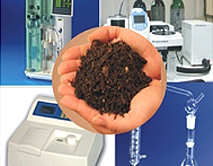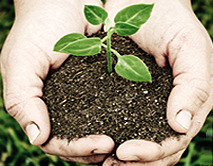
"Swasth Dharaa. Khet Haraa." - Healthy Earth. Green Farm.
A Soil Health Card is used to assess the current status of soil health and, when used over time, to determine changes in soil health that are affected by land management. A Soil Health Card displays soil health indicators and associated descriptive terms. The indicators are typically based on farmers' practical experience and knowledge of local natural resources. The card lists soil health indicators that can be assessed without the aid of technical or laboratory equipment.
Soil Health Card (SHC) is a Government of India's scheme promoted by the Department of Agriculture & Co-operation under the Ministry of Agriculture and Farmers' Welfare. It is being implemented through the Department of Agriculture of all the State and Union Territory Governments.
Soil Health Card Scheme is a very beneficial scheme for farmers. There are many farmers in India. And they do not know which types of crops they should grow to get maximum yield. Basically, they do not know the quality and the type of their soil. They might know by experience what crops grow and what crops fail. But they don't know what they can do to improve the condition of the soil.

- The government is planning to cover as many as all farmers under the scheme.
- The scheme will cover all the parts of the country.
- In the form of soil card, the farmers will get a report. and this report will contain all the details about the soil of their particular farm.
- A farm will get the soil card once in every 3 years.
About Soil Health Card
A step-by-step process for leading farmers in identifying soil health indicators and developing a Soil Health Card. The outcomes of facilitated farmer meetings include a user-friendly, do-it-yourself tool to assess soil health as well as mutually beneficial dialog among farmers and technical specialists.
What is a Soil Health Card?
SHC is a printed report that a farmer will be handed over for each of his holdings. It will contain the status of his soil with respect to 12 parameters, namely N,P,K (Macro-nutrients); S (Secondary- nutrient); Zn, Fe, Cu, Mn, Bo (Micro - nutrients); and pH, EC, OC (Physical parameters). Based on this, the SHC will also indicate fertilizer recommendations and soil amendment required for the farm.
How can a farmer use a SHC?
The card will contain an advisory based on the soil nutrient status of a farmer's holding. It will show recommendations on dosage of different nutrients needed. Further, it will advise the farmer on the fertilizers and their quantities he should apply, and also the soil amendments that he should undertake, so as to realize optimal yields.
What are the norms of sampling?
Soil samples will be drawn in a grid of 2.5 ha in irrigated area and 10 ha in rain- fed area with the help of GPS tools and revenue maps.
Who will draw the soil sample?
The State Government will collect samples through the staff of their Department of Agriculture or through the staff of an outsourced agency. The State Government may also involve the students of local Agriculture / Science Colleges.
What is the ideal time for soil sampling?
Soil Samples are taken generally two times in a year, after harvesting of Rabi and Kharif Crop respectively or when there is no standing crop in the field.
How will soil samples be collected from a farmer's field?
Soil Samples will be collected by a trained person from a depth of 15-20 cm by cutting the soil in a "V" shape. It will be collected from four corners and the centre of the field and mixed thoroughly and a part of this picked up as a sample. Areas with shade will be avoided. The sample chosen will be bagged and coded. It will then be transferred to soil test laboratory for analysis.
Who and Where will the soil sample be tested?
The soil sample will be tested as per the approved standards for all the agreed 12 parameters in the following way:
- At the STLs owned by the Department of Agriculture and by their own staff.
- At the STLs owned by the Department of Agriculture but by the staff of the outsourced agency.
- At the STLs owned by the outsourced agency and by their staff.
- At ICAR Institutions including KVKs and SAUs.
- At the laboratories of the Science Colleges/Universities by the students under supervision of a Professor/ Scientist.
What is the payment per sample?
A sum of Rs. 190 per soil sample is provided to State Governments. This covers the cost of collection of soil sample, its test, generation and distribution of soil health card to the farmer.

- The scheme will monitor the soil of the farmers well and will give them a formatted report. So, they can decide well which crops they should cultivate and which ones they should skip.
- The authorities will monitor the soil on a regular basis. One in every 3 years, they will provide a report to farmers. So, farmers need not worry if the nature of the soil changes due to certain factors. Also, they will always have updated data about their soil.
- The work of the government does not stop at listing down measures required to improve the quality of the soil. In fact, they will also employ experts to help farmers in carrying out the corrective measures.
- Farmers will get a proper soil health record, thanks to the Soil Health Card Scheme. Also, they can study the soil management practices. Accordingly, they can plan the future of their crops and land.
- Generally, in government schemes, the person carrying out the study for a particular farmer gets changed. But in the Soil Health Card Scheme, the government is paying attention that the same person carries out soil analysis for a farmer. This will further enhance the effectiveness of the scheme.
- The soil card will give the farmers a proper idea of which nutrients their soil is lacking. And hence, which crops they should invest in. they will also tell which fertilizers they need. So, ultimately, the crop yield will see a rise.
- The main aim behind the scheme was to find out the type of particular soil. And then provide ways in which we can improve it. Even if a soil has some limitations, we can do something to get the most out of it. And that is what the government is trying to do with the help of this scheme.
Related Links





